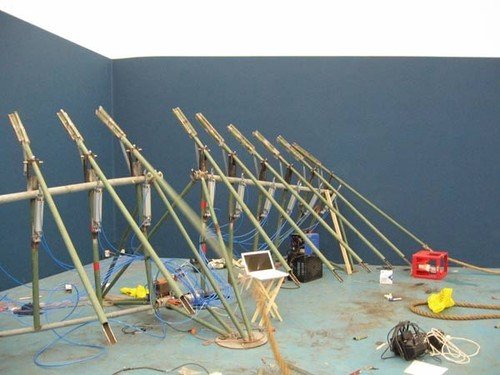The Breakers / De Branding
dal 4/4/2008 al 3/5/2008
Segnalato da
4/4/2008
The Breakers / De Branding
W139 (Old location), Amsterdam
An exhibition of work by Zoro Feigl and Natasha Rosling in collaboration with the Zuiderzeemuseum. From ships and ropes, compasses and lamps to statues and paintings: the two artists have selected a wide range of objects in order to set up a sort of constellation of craftsmanship, art, consumer goods and machine.

During the construction period of the exhibition is w139 open.
The industrial revolution gradually stripped human labour of its craft. It also disrupted the progressive evolution from tool to utensil to work of art. A blacksmith crafted his own hammers and tongs and because he wrought decorate fencing, and the weapons he made also possessed a certain elegance. Large sculptures and commissioned portraits, editions of saints and signboards were produced in artists studios and, within this context, there was no hard and fast distinction between functionality and beauty. But, with the advent and use of machines, however, this distinction became increasingly evident. Before the invention of the camera, the difference between visible and invisible could not be objectified. In a similar way, industrial production drove an immovable wedge between the originally progressive transition from tool to art object. Utensils are developed in line with a globally accepted set of quantifiable standards; art, on the other hand, seems solely to have become the terrain of assigned qualities. This crisis in the position of the visual arts is closely linked to the crisis in the current production and economy of consumer goods. After an optimistic start, the objective mission of industrialisation foundered in the contemporary economy of apparent free choice . Although the global development of technology and economics should lead to perfection and quality, instead the diseased fruits of the experience economy are spewed all over us. Truth be told, we only need one type of car and kind of ballpoint pen. Every outward variation of cutlery, folding chairs, telephones or computers is pointless and decadent. As long as industrial products are not purely anonymous and functional, they will continue to blank out the identification of essential human needs. Art can only unfold its essential power once we have literally achieved that super-human level of product development; until which time, it is doomed to a position of critique on the sidelines or the production of commodities.
The constellation of craftsmanship, art, consumer goods and machine is the domain of The Breakers / De Branding. The objects that Feigl and Rosling have selected from the Zuiderzeemuseum collection cover the entire spectrum set out above. From ships and ropes, compasses and lamps to statues and paintings.
Natasha Rosling makes large coloured sculptures of wood, iron, textile and paint. Human beings can also be part of the sculpture: suspended from it inside a pair of trousers they have been sewn into, or carrying it through the streets. Her evident emphasis on the primacy of the senses was the reason for inviting her to take part in The Breakers / De Branding. The exhibition centres on taking objects from the Zuiderzeemuseum that, up to now, have been stored out of sight or rendered harmless in a didactic museum display and using them as material for a new work. Rosling begins by stacking objects against the front window of W139, and will work her way into the front space.
Zoro Feigl 's works render force visible. The power of an effective piece of machinery is fully absorbed by its function. Feigl transforms this power into exhausting visibility. In a sense, his pieces are all fountains: phenomenon somewhere between propulsion and gravity. Like Sugarstorm, an open candyfloss machine that sends a whirlwind of pink cotton candy spinning into the air through four ventilators, and keeps coming loose of the floor. Or Bouncing Balls, two pillars of silver inflatable balls that bounce on top of each other, driven by a crankshaft-motored drill. The gist of his work lies in the fact that you 're aware that the pieces just about hold together but, at any second, the engine could catch fire or a knot in the rope could bring the whole thing to a standstill. One of the pieces Feigl will create for The Breakers / De Branding, Feigl is a sea of pneumatically-driven rope waves in the rear space.
W139
Pakt Zeeburgerpad 53 - Amsterdam



